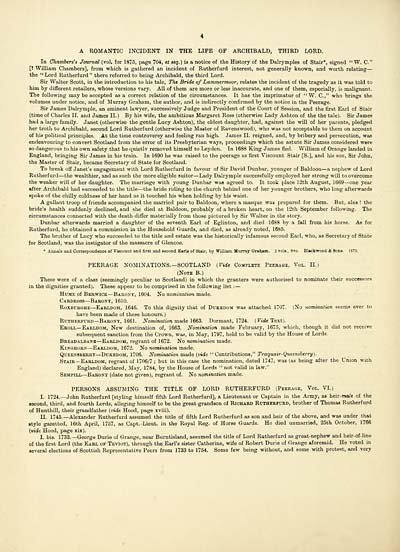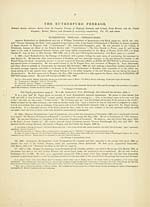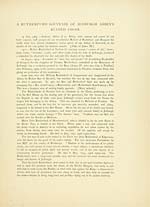Rutherfurds of that Ilk, and their cadets
(138) Page cx
Download files
Complete book:
Individual page:
Thumbnail gallery: Grid view | List view

A ROMANTIC INCIDENT IN THE LIFE OF ARCHIBALD, THIRD LORD.
In Chambers's Journal (vol. for 1875, page 704, et seq.) is a notice of the History of the Dalrymples of Stair*, signed " W. C."
[! William Chambers], from which is gathered an incident of Rutherfurd interest, not generally known, and worth relating —
the " Lord Rutherfurd " there referred to being Archibald, the third Lord.
Sir Walter Scott, in the introduction to his tale, The Bride of Lammermuor, relates the incident of the tragedy as it was told to
him by different retailers, whose versions vary. All of them are more or less inaccurate, and one of them, especially, is malignant.
The following may be accepted as a correct relation of the circumstances. It has the imprimatur of " W. C," who brings the
volumes under notice, and of Murray Graham, the author, and is indirectly confirmed by the notice in the Peerage.
Sir James Dalrymple, an eminent lawyer, successively Judge and President of the Court of Session, and the first Earl of Stair
(time of Charles II. and James II.) By his wife, the ambitious Margaret Ross (otherwise Lady Ashton of the the tale). Sir James
had a large family. Janet (otherwise the gentle Lucy Ashton), the eldest daughter, had, against the will of her parents, pledged
her troth to Archibald, second Lord Rutherfurd (otherwise the Master of Ravenswood), who was not acceptable to them on account
of his political principles. At the time controversy and feeling ran high. James II. reigned, and, by bribery and persecution, was
endeavouring to convert Scotland from the error of its Presbyterian ways, proceedings which the astute Sir James considered were
so dangerous to his own safety that he quietly removed himself to Leyden. In 1688 King James fled. William of Orange landed in
England, bringing Sir James in his train. In 1690 he was raised to the peerage as first Viscount Stair [S.], and his son, Sir John,
the Master of Stair, became Secretary of State for Scotland.
To break off Janet's engagement with Lord Rutherfurd in favour of Sir David Dunbar, younger of Baldoon — a nephew of Lord
Rutherfurd — the wealthier, and as such the more eligible suitor — Lady Dalrymple successfully employed her strong will to overcome
the weaker will of her daughter. The marriage with young Dunbar was agreed to. It took place 12th August, 1669 — one year
after Archibald had succeeded to the title — the bride riding to the church behind one of her younger brothers, who long afterwards
spoke of the chilly coldness of her hand as it touched his when holding by his waist.
A gallant troop of friends accompanied the married pair to Baldoon, where a masque was prepared for them. But, alas ! the
bride's health suddenly declined, and she died at Baldoon, probably of a broken heart, on the 12th September following. The
circumstances connected with the death differ materially from those pictured by Sir Walter in the story.
Dunbar afterwards married a daughter of the seventh Earl of Eglinton, and died 1688 by a fall from his horse. As for
Rutherfurd, he obtained a commission in the Household Guards, and died, as already noted, 1685.
The brother of Lucy who succeeded to the title and estate was the historically infamous second Earl, who, as Secretary of State
for Scotland, was the instigator of the massacre of Glencoe.
* Annals and Correspondence of Viscount and first and second Earls of Stair, by William Murray Graham. 2 vols., 8to. Blackwood <fe Sodb. 1875.
PEERAGE NOMINATIONS.— SCOTLAND (Vide Complete Peekage, Vol. II.)
(Note B.)
These were of a class (seemingly peculiar to Scotland) in which the granters were authorised to nominate their successors
in the dignities granted). These appear to be comprised in the following list : —
Hume of Berwick — Barony, 1604. No nomination made.
Cardross— Barony, 1610.
Roxburghe— Earldom, 1646. To this dignity that of Dukedom was attached 1707. (No nomination seems ever to
have been made of these honours. )
Rutherfurd— Barony, 1661. Nomination made 1663. Dormant, 1724. ( Vide Text).
Eroll— Earldom, New destination of, 1663. Nomination made February, 1675, which, though it did not receive
subsequent sanction from the Crown, was, in May, 1797, held to be valid by the House of Lords.
Breadalbane — Earldom, regrant of 1672. No nomination made.
Kinghorn — Earldom, 1672. No nomination made.
Queensberry — Dukedom, 1706. Nomination made (vide "Contributions," Traquair-Queensberry).
Stair— Earldom, regrant of 1706/7 ; but in this case the nomination, dated 1747, was (as being after the Union with
England) declared, May, 1784, by the House of Lords " not valid in law."
Sempill — Barony (date not given), regrant of. No nomination made.
PERSONS ASSUMING THE TITLE OF LORD RUTHERFURD (Peerage, Vol. VI.)
I. 1724.— John Rutherfurd [styling himself fifth Lord Rutherfurd], a Lieutenant or Captain in the Army, as heir-male of the
second, third, and fourth Lords, alleging himself to be the great-grandson of Richard Rutherfurd, brother of Thomas Rutherfurd
of Hunthill, their grandfather (vide Hood, page xviii).
II. 1745.— Alexander Rutherfurd assumed the title of fifth Lord Rutherfurd as son and heir of the above, and was under that
style gazetted, 16th April, 1757, as Capt.-Lieut. in the Royal Reg. of Horse Guards. He died unmarried, 25th October, 1766
(vide Hood, page xix).
I. bis. 1733.— George Durie of Grange, near Burntisland, assumed the title of Lord Rutherfurd as great-nephew and heir-of-line
of the first Lord (the Earl of Teviot), through the Earl's sister Catherine, wife of Robert Durie of Grange aforesaid. He voted in
several elections of Scottish Representative Peers from 1733 to 1754. Some few being without, and some with protest, and very
In Chambers's Journal (vol. for 1875, page 704, et seq.) is a notice of the History of the Dalrymples of Stair*, signed " W. C."
[! William Chambers], from which is gathered an incident of Rutherfurd interest, not generally known, and worth relating —
the " Lord Rutherfurd " there referred to being Archibald, the third Lord.
Sir Walter Scott, in the introduction to his tale, The Bride of Lammermuor, relates the incident of the tragedy as it was told to
him by different retailers, whose versions vary. All of them are more or less inaccurate, and one of them, especially, is malignant.
The following may be accepted as a correct relation of the circumstances. It has the imprimatur of " W. C," who brings the
volumes under notice, and of Murray Graham, the author, and is indirectly confirmed by the notice in the Peerage.
Sir James Dalrymple, an eminent lawyer, successively Judge and President of the Court of Session, and the first Earl of Stair
(time of Charles II. and James II.) By his wife, the ambitious Margaret Ross (otherwise Lady Ashton of the the tale). Sir James
had a large family. Janet (otherwise the gentle Lucy Ashton), the eldest daughter, had, against the will of her parents, pledged
her troth to Archibald, second Lord Rutherfurd (otherwise the Master of Ravenswood), who was not acceptable to them on account
of his political principles. At the time controversy and feeling ran high. James II. reigned, and, by bribery and persecution, was
endeavouring to convert Scotland from the error of its Presbyterian ways, proceedings which the astute Sir James considered were
so dangerous to his own safety that he quietly removed himself to Leyden. In 1688 King James fled. William of Orange landed in
England, bringing Sir James in his train. In 1690 he was raised to the peerage as first Viscount Stair [S.], and his son, Sir John,
the Master of Stair, became Secretary of State for Scotland.
To break off Janet's engagement with Lord Rutherfurd in favour of Sir David Dunbar, younger of Baldoon — a nephew of Lord
Rutherfurd — the wealthier, and as such the more eligible suitor — Lady Dalrymple successfully employed her strong will to overcome
the weaker will of her daughter. The marriage with young Dunbar was agreed to. It took place 12th August, 1669 — one year
after Archibald had succeeded to the title — the bride riding to the church behind one of her younger brothers, who long afterwards
spoke of the chilly coldness of her hand as it touched his when holding by his waist.
A gallant troop of friends accompanied the married pair to Baldoon, where a masque was prepared for them. But, alas ! the
bride's health suddenly declined, and she died at Baldoon, probably of a broken heart, on the 12th September following. The
circumstances connected with the death differ materially from those pictured by Sir Walter in the story.
Dunbar afterwards married a daughter of the seventh Earl of Eglinton, and died 1688 by a fall from his horse. As for
Rutherfurd, he obtained a commission in the Household Guards, and died, as already noted, 1685.
The brother of Lucy who succeeded to the title and estate was the historically infamous second Earl, who, as Secretary of State
for Scotland, was the instigator of the massacre of Glencoe.
* Annals and Correspondence of Viscount and first and second Earls of Stair, by William Murray Graham. 2 vols., 8to. Blackwood <fe Sodb. 1875.
PEERAGE NOMINATIONS.— SCOTLAND (Vide Complete Peekage, Vol. II.)
(Note B.)
These were of a class (seemingly peculiar to Scotland) in which the granters were authorised to nominate their successors
in the dignities granted). These appear to be comprised in the following list : —
Hume of Berwick — Barony, 1604. No nomination made.
Cardross— Barony, 1610.
Roxburghe— Earldom, 1646. To this dignity that of Dukedom was attached 1707. (No nomination seems ever to
have been made of these honours. )
Rutherfurd— Barony, 1661. Nomination made 1663. Dormant, 1724. ( Vide Text).
Eroll— Earldom, New destination of, 1663. Nomination made February, 1675, which, though it did not receive
subsequent sanction from the Crown, was, in May, 1797, held to be valid by the House of Lords.
Breadalbane — Earldom, regrant of 1672. No nomination made.
Kinghorn — Earldom, 1672. No nomination made.
Queensberry — Dukedom, 1706. Nomination made (vide "Contributions," Traquair-Queensberry).
Stair— Earldom, regrant of 1706/7 ; but in this case the nomination, dated 1747, was (as being after the Union with
England) declared, May, 1784, by the House of Lords " not valid in law."
Sempill — Barony (date not given), regrant of. No nomination made.
PERSONS ASSUMING THE TITLE OF LORD RUTHERFURD (Peerage, Vol. VI.)
I. 1724.— John Rutherfurd [styling himself fifth Lord Rutherfurd], a Lieutenant or Captain in the Army, as heir-male of the
second, third, and fourth Lords, alleging himself to be the great-grandson of Richard Rutherfurd, brother of Thomas Rutherfurd
of Hunthill, their grandfather (vide Hood, page xviii).
II. 1745.— Alexander Rutherfurd assumed the title of fifth Lord Rutherfurd as son and heir of the above, and was under that
style gazetted, 16th April, 1757, as Capt.-Lieut. in the Royal Reg. of Horse Guards. He died unmarried, 25th October, 1766
(vide Hood, page xix).
I. bis. 1733.— George Durie of Grange, near Burntisland, assumed the title of Lord Rutherfurd as great-nephew and heir-of-line
of the first Lord (the Earl of Teviot), through the Earl's sister Catherine, wife of Robert Durie of Grange aforesaid. He voted in
several elections of Scottish Representative Peers from 1733 to 1754. Some few being without, and some with protest, and very
Set display mode to:
![]() Universal Viewer |
Universal Viewer | ![]() Mirador |
Large image | Transcription
Mirador |
Large image | Transcription
Images and transcriptions on this page, including medium image downloads, may be used under the Creative Commons Attribution 4.0 International Licence unless otherwise stated. ![]()
| Histories of Scottish families > Rutherfurds of that Ilk, and their cadets > (138) Page cx |
|---|
| Permanent URL | https://digital.nls.uk/95748991 |
|---|
| Description | A selection of almost 400 printed items relating to the history of Scottish families, mostly dating from the 19th and early 20th centuries. Includes memoirs, genealogies and clan histories, with a few produced by emigrant families. The earliest family history goes back to AD 916. |
|---|

